| Volume 2012, Issue 17 | May 22, 2012 |
|

Pick and Gather at Riverdance Farms and Merced River Fair:
June 2-3
National Conference on Engineering & Ecohydrology for Fish Passage:
June 5-7
|
|

|
Key Highlights
April 30, 2012 - May 13, 2012
Calaveras River Juvenile Migration Monitoring continued at Shelton Road (RM 28) and a total of 48 O. mykiss were captured, increasing the season total to 646. A total of 612 Chinook salmon were also captured, bringing the season total to 1,233.
Stanislaus River Juvenile Migration Monitoring continued at Oakdale (RM 40) and a total of 936 Chinook salmon were captured, increasing the season total to 24,532. One O. mykiss was captured, increasing the season total to 27. Monitoring at Caswell State Park (RM 8) continued during the reporting period. A total of 253 Chinook salmon were captured, increasing the season total to 680.
Tuolumne River Juvenile Migration Monitoring continued at Waterford (RM 30) and a total of 181 Chinook salmon were captured, increasing the season total to 3,546. Monitoring at Grayson (RM 5) also continued and a total of 36 Chinook salmon were captured, increasing the season total to 81. No O. mykiss have been captured this season at Waterford or Grayson.
Mokelumne River Juvenile Migration Monitoring continued at Vino Farms (RM 54) and a total of 43 Chinook salmon were captured, increasing the season total to 12,399. Seven O. mykiss were captured, increasing the season total to 44. Monitoring at the Bypass trap (RM 38) continued and a total of 1,372 Chinook salmon were captured, increasing the season total to 1,473. A total of 14 O. mykiss were captured, increasing the season total to 27. Monitoring at Golf (RM 38) also continued and a total of 112 Chinook salmon were captured during the reporting period, increasing the season total to 1,059. No O. mykiss were captured and the season total remains at 147.
San Joaquin River Juvenile Migration Monitoring. The California Department of Fish and Game (CDFG) continued Kodiak Trawling on the San Joaquin River near Mossdale. A total of 670 Chinook salmon were captured, increasing the season total to 2,027.
Tuolumne River Weir Monitoring (RM 22) was temporarily suspended on May 8. A total of six Chinook salmon passed upstream through the weir, increasing the season total to 2,893. One O. mykiss passed upstream through the weir during the reporting period, increasing the season total to 15.
San Joaquin River Conditions. San Joaquin River flow at Vernalis ranged from 2,399 cfs to 4,381 cfs. Daily average water temperature in the San Joaquin River ranged from 62.4°F to 66.1°F at Vernalis, and from 64.3°F to 68.4°F at Mossdale. Daily average dissolved oxygen (DO) in the San Joaquin River ranged from 8.8 mg/L to 9.6 mg/L at Mossdale, and from 7.3 mg/L to 8.1 mg/L in the deep-water ship channel (measured at Rough 'n Ready Island).
Delta Exports. Combined total exports (state and federal pumps) fluctuated during the reporting period, ranging from 1,243 cfs to 4,167cfs.
|
|
2011/12 Calaveras River Juvenile Migration Monitoring
The Calaveras River rotary screw trap at Shelton Road (RM 28) sampled continuously between April 30 and May 13. A total of 48 O. mykiss were captured, increasing the season total to 646. Daily catch ranged from 0 to 9 individuals (Figure 1). Average forklengths and weights for 47 O. mykiss are provided in Table 1. A majority of the O. mykiss measured were YOY (<100 mm), and were rated as fry (n=5), parr (n=33) and silvery parr (n=5), but two Age 1+ (100-299 mm) were also observed and rated as smolts.
A total of 612 Chinook salmon were captured during the reporting period, increasing the season total to 1,233. Daily catch ranged between 12 and 121 Chinook (Figure 2). Most of the Chinook salmon measured were smolt (n=488) but parr (n=6) were also observed and average forklengths and weights are provided in Table 1.
Daily average combined flows from New Hogan Dam (NHG) and Cosgrove Creek (COS) fluctuated between 89 cfs and 185 cfs, and at Bellota (MRS) flows ranged from 24 cfs to 51 cfs (Figure 3). Instantaneous water temperatures recorded at the trap ranged from 54.5ºF to 67.7ºF, and turbidity ranged from 0.34 NTU to 9.50 NTU.
Three trap efficiency experiments were conducted with naturally spawned juvenile Chinook salmon. Preliminary estimates of capture efficiency are provided in Table 2.
Table 1. Biosampling data for salmonids captured at Shelton Road (RM 28) between April 30 and May 13, 2012. Parenthesis indicates range.
 Table 2. Trap efficiency tests conducted at Shelton Road (RM 28) between April 30 and May 13, 2012. 

Figure 1. Daily O. mykiss catch at Shelton Road between October 15, 2011, and May 13, 2012.
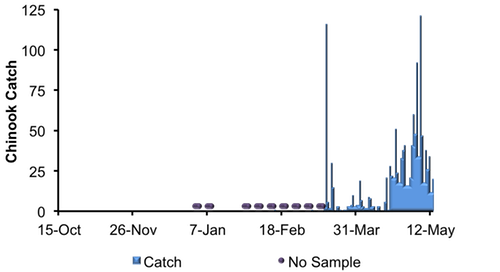
Figure 2. Daily Chinook salmon catch at Shelton Road between October 15, 2011, and May 13, 2012.
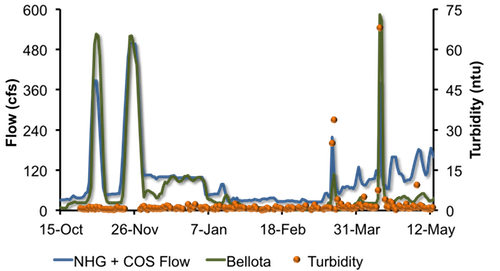
Figure 3. Daily Calaveras River flows recorded at New Hogan Dam and Cosgrove Creek combined (NHG + COS) and at Bellota (MRS) and turbidity recorded at the trap between October 15, 2011, and May 13, 2012.
|
2011/12 Stanislaus River Juvenile Migration Monitoring
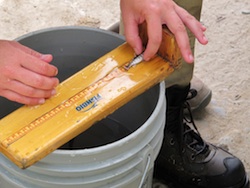 The Stanislaus River rotary screw trap at Oakdale (RM 40) sampled continuously between April 30 and May 13. A total of 936 Chinook salmon were captured, increasing the season total to 24,532. Daily catch ranged between 33 and 159 Chinook (Figure 4). Most of the Chinook salmon measured were smolts (n=519), but parr (n=123) were also observed. Average forklengths and weights of all measured Chinook salmon are provided in Table 2. The Stanislaus River rotary screw trap at Oakdale (RM 40) sampled continuously between April 30 and May 13. A total of 936 Chinook salmon were captured, increasing the season total to 24,532. Daily catch ranged between 33 and 159 Chinook (Figure 4). Most of the Chinook salmon measured were smolts (n=519), but parr (n=123) were also observed. Average forklengths and weights of all measured Chinook salmon are provided in Table 2.
One O. mykiss was captured during the reporting period, increasing the season total to 27.
Table 2. Biosampling data for salmonids captured and measured at Oakdale (RM 40) between April 30 and May 13, 2012.
 No trap efficiency experiments were conducted during the reporting period. Daily average flows at Goodwin Dam (GDW) ranged from 1,499 cfs to 1,525 cfs, and at Ripon (RIP) ranged from 1,507 cfs to 1,548 cfs. Instantaneous water temperatures taken at the trap ranged from 51.8ºF to 56.5ºF, and turbidity ranged from 0.29 NTU to 1.76 NTU.
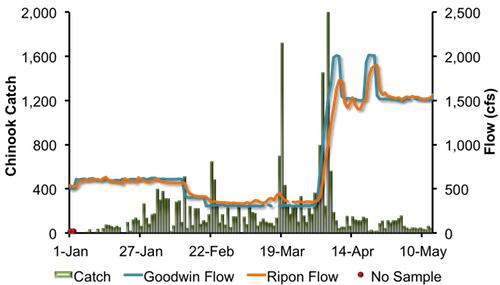
Figure 4. Daily Chinook salmon catch at Oakdale (RM 40) and daily average Stanislaus River flows at Goodwin Dam (GDW) and Ripon (RIP) between January 1, 2012, and May 13, 2012.
The Stanislaus River rotary screw trap at Caswell State Park (RM 8) sampled continuously during the reporting period and a total of 253 juvenile Chinook salmon were captured, increasing the season total to 680.
Instantaneous temperature recorded at the trap ranged from 55.4°F and 59.0°F, and turbidity ranged from 2.28 NTU to 3.96 NTU. Daily average flow at Ripon (RIP) ranged from to 1,507 cfs to 1,548 cfs.
|
2012 Tuolumne River Juvenile Migration Monitoring
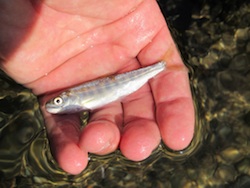 The Tuolumne River rotary screw trap at Waterford (RM 30) operated continuously between April 30 and May 13. A total of 181 juvenile Chinook salmon were captured, increasing the season total to 3,546. Daily catch ranged between 1 and 48 Chinook (Figure 5). Average forklengths and weights of all measured Chinook salmon are provided in Table 3. Most of the Chinook salmon measured were smolts (n=176), but parr (n=3) were also observed. The Tuolumne River rotary screw trap at Waterford (RM 30) operated continuously between April 30 and May 13. A total of 181 juvenile Chinook salmon were captured, increasing the season total to 3,546. Daily catch ranged between 1 and 48 Chinook (Figure 5). Average forklengths and weights of all measured Chinook salmon are provided in Table 3. Most of the Chinook salmon measured were smolts (n=176), but parr (n=3) were also observed.
No O. mykiss have been captured this season.
Table 3. Biosampling data for Chinook salmon captured and measured at Waterford (RM 30) between April 30 and May 13, 2012. Parentheses indicate range.
No trap efficiency experiments were conducted during the reporting period.
Daily average flows at La Grange (LGN) increased from 393 cfs to 2,130 cfs. Instantaneous water temperatures taken at the trap ranged from 59.0ºF to 68.9ºF, and turbidity ranged from 0.65 NTU to 4.53 NTU. Figure 5. Daily Chinook salmon catch at Waterford (RM 30) and daily average Tuolumne River flows at La Grange (LGN) and between December 1, 2011, and May 13, 2012. The Tuolumne River rotary screw traps at Grayson (RM 5) operated continuously between April 30 and May 13. A total of 36 Chinook salmon were captured during the reporting period, increasing the season total to 81. Daily catch ranged between 0 and 10 Chinook (Figure 6). Average forklengths and weights of all measured Chinook salmon are provided in Table 5. All Chinook salmon captured were smolts (n=36). No O. mykiss have been captured this season.
Table 5. Biosampling data for Chinook salmon captured and measured at Grayson (RM 5) between April 30 and May 13, 2012. Parentheses indicate range.
No trap efficiency experiments were conducted. Daily average flow at Modesto (MOD) increased from 496 cfs to 1,940 cfs. Instantaneous water temperatures taken at the trap ranged from 58.6ºF to 70.1ºF, and turbidity ranged from 1.08 NTU to 10.97 NTU.Figure 6. Daily Chinook salmon catch at Grayson and Tuolumne River flow recorded at Modesto (MOD) between January 1 and May 13, 2012.
|
2011/12 Mokelumne River Juvenile Migration Monitoring
The Mokelumne River rotary screw trap at Vino Farms (RM 54) sampled intermittently between April 30 and May 13. A total of 43 juvenile Chinook salmon were captured, bringing the season total to 12,399. Daily catch ranged between 1 and 11 Chinook (Figure 7).
Seven O. mykiss were captured, increasing the season total to 44.
Daily average flows from Camanche Reservoir (CMN) were stable, ranging from 273 cfs to 348 cfs. Instantaneous water temperatures ranged between 54.9°F and 57.6°F, and instantaneous turbidity ranged between 1.84 NTU and 3.79 NTU.
 Figure 7. Daily juvenile Chinook catch at Vino Farms (RM 54) and daily average Mokelumne River flows at Camanche Reservoir (CMN) between December 1, 2011, and May 13, 2012. The Mokelumne River Bypass trap (RM 38) sampled intermittently between April 30 and May 13. A total of 1,372 juvenile Chinook salmon were captured during the reporting period, increasing the season total to 1,473. A total of 14 O. mykiss were captured during the reporting period, increasing the season total to 27. Daily average flows recorded at Woodbridge (WBR) ranged from 128 cfs to 145 cfs (Figure 8). Instantaneous water temperatures ranged between 63.1°F and 66.6°F, and turbidity ranged between 2.22 NTU and 3.24 NTU. 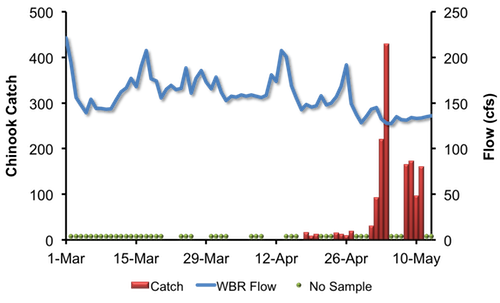
Figure 8. Daily juvenile Chinook catch at the Bypass trap (RM 38) and daily average Mokelumne River flows at Woodbridge (WBR), between March 1, 2012, and May 13, 2012. The Mokelumne River rotary screw trap at Golf (RM 38) sampled intermittently between April 30 and May 13. A total of 112 juvenile Chinook salmon were captured, increasing the season total of 1,059 (Figure 9). No O. mykiss were captured during the reporting period. Season total remains at 147. (Note: 135 were identified as hatchery origin).
Figure 9. Daily juvenile Chinook catch at the rotary screw trap at Golf (RM 38) and daily average Mokelumne River flows at Woodbridge (WBR), between December 15, 2011, and May 13, 2012.
|
2012 San Joaquin River Juvenile Migration Monitoring
The Kodiak trawling that is conducted by the California Department of Fish and Game on the San Joaquin River near Mossdale (i.e. the Mossdale Trawl) continued during the reporting period. Ten days (ten tows per day) of trawling were conducted between April 30 and May 13. A total of 670 juvenile Chinook salmon were captured, increasing the season total to 2,027. Catch ranged between 5 and 166 Chinook per 10 tows (Figure 10).Six O. mykiss were captured during the reporting period, increasing the season total to 15.

Figure 10. Chinook salmon catch (per 10 tows) at the Mossdale Trawl and San Joaquin River flow recorded by Vernalis (VNS), 2012.
|
2011 Tuolumne River Weir Adult Migration Monitoring
Tuolumne River Weir and Vaki Riverwatcher (RM 22) monitoring was temporarily suspended due to increased flows between May 8 and May 14. A total of six Chinook salmon were detected as they passed upstream of the weir, increasing the season total to 2,893. Daily passage ranged between zero and two Chinook salmon. Monitoring is expected to resume May 21.
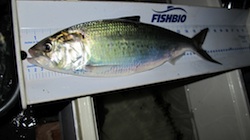 One naturally spawned O. mykiss was detected passing upstream of the weir during the reporting period, increasing the season total to 11 naturally spawned (non adipose fin clipped) and four hatchery origin (adipose fin clipped) O. mykiss. One naturally spawned O. mykiss was detected passing upstream of the weir during the reporting period, increasing the season total to 11 naturally spawned (non adipose fin clipped) and four hatchery origin (adipose fin clipped) O. mykiss.
Other fish passing upstream of the weir included 13 American shad and 241 Sacramento suckers (Table 6).
Daily average flows in the Tuolumne River ranged from 393 cfs to 2,130 cfs at La Grange (LGN; RM 50) and from 496 cfs to 1,940 cfs at Modesto (MOD; RM 17). Note: flows downstream of La Grange may be higher than dam releases due to accretion and flows from Dry Creek (Figure 11). Instantaneous water temperatures measured at the weir ranged from 59.7˚F and 68.0˚F and daily average water temperatures at Modesto ranged from 59.0˚F and 68.9˚F (Figure 12). Instantaneous turbidity at the weir ranged between 1.72 NTU and 3.32 NTU (Figure 13), and dissolved oxygen ranged between 10.25 mg/L and 11.64 mg/L (Figure 14).
Table 6. Net passage counts for all species between April 30 and May 13, 2012 at the Tuolumne River (RM 22).
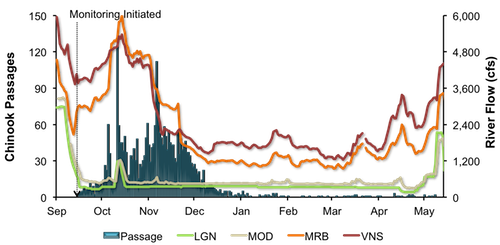
Figure 11. Daily upstream Chinook passage at the Tuolumne River weir in relation to daily average flows (cfs) recorded in the Tuolumne River at La Grange (LGN) and Modesto (MOD), and in the San Joaquin River at Maze Road Bridge (MRB) and Vernalis (VNS), September 1, 2011 and May 13, 2012.
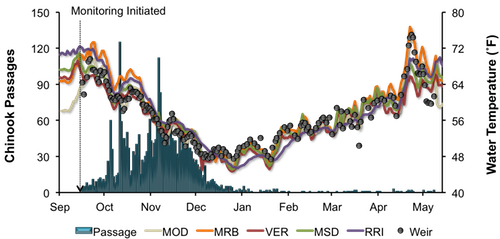
Figure 12. Daily upstream Chinook passage at the Tuolumne River weir in relation to instantaneous water temperature recorded at the weir, and daily average water temperature recorded in the Tuolumne River at Modesto (MOD) and in the San Joaquin River at Maze Road Bridge (MRB), Vernalis (VER), Mossdale (MSD) and Rough & Ready (RRI), September 1, 2011 and May 13, 2012.

Figure 13. Daily upstream Chinook passage at the Tuolumne River weir in relation to instantaneous turbidity recorded at the weir, September 1, 2011 and May 13, 2012.
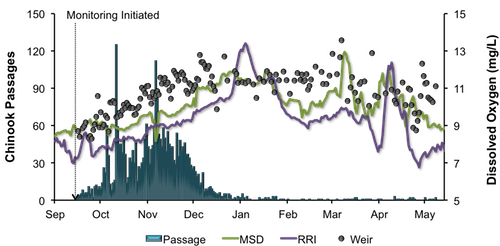
Figure 14. Daily upstream Chinook passage at the Tuolumne River weir in relation to instantaneous dissolved oxygen recorded at the weir, and daily average dissolved oxygen recorded in the San Joaquin River at Mossdale (MSD) and Rough & Ready (RRI), September 1, 2011 and May 13, 2012.
|
San Joaquin River Conditions
During the reporting period, flow in the San Joaquin River at Vernalis ranged from 2,399 cfs to 4,381 cfs (Figure 15). Daily average water temperature in the San Joaquin River ranged from 62.4°F to 66.1°F at Vernalis, from 64.3°F to 68.4°F at Mossdale, and from 65.6°F to 70.0°F at Rough 'n Ready Island (Figure 16). Daily average dissolved oxygen (DO) in the San Joaquin River fluctuated from 8.8 mg/L to 9.6 mg/L at Mossdale, and from 7.3 mg/L to 8.1 mg/L in the deep-water ship channel (measured at Rough 'n Ready Island; Figure 17).
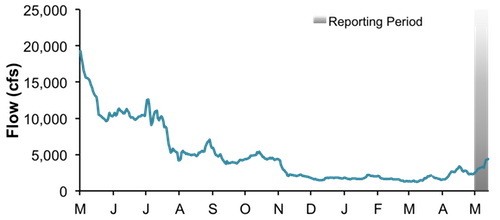
Figure 15. San Joaquin River flows at Vernalis between May 1, 2011, and May 13, 2012.
Figure 16. San Joaquin River daily average water temperature at Vernalis, Mossdale, and Rough 'n Ready between May 1, 2011, and May 13, 2012.
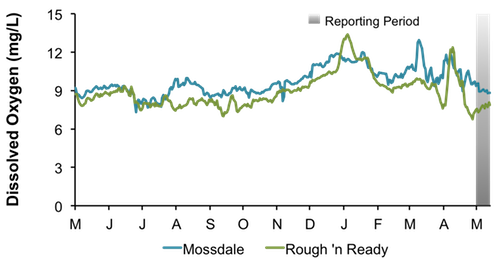
Figure 17. San Joaquin River daily average dissolved oxygen at Mossdale and Rough 'n Ready between May 1, 2011, and May 13, 2012.
|
Delta ExportsMean daily pumping at the C.W. Jones Pumping Plant (federal pumps previously known as Tracy Pumping Plant) ranged from 816 cfs to 1,004 cfs (Figure 18). Mean daily pumping at the Harvey O. Banks Pumping Plant (state pumps) fluctuated between 427 cfs to 3,350 cfs. Combined total exports (state and federal pumps) fluctuated during this reporting period, ranging from 1,243 cfs to 4,167 cfs.
Figure 18. Daily exports at the state and federal pumping stations between May 1, 2011, and May 13, 2012.
|
|
|
|
|
|
|